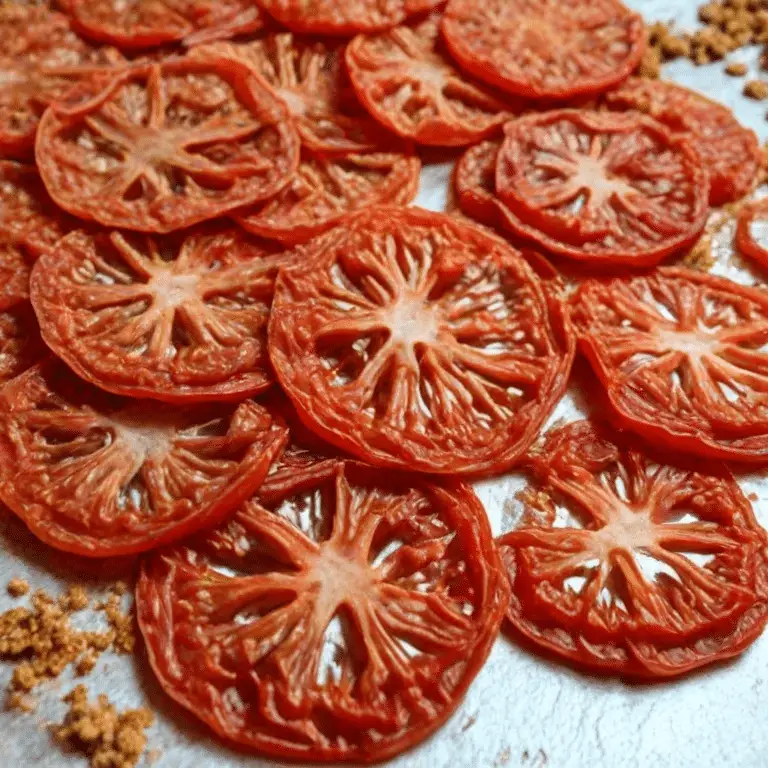




Want to keep the flavor and nutrients of tomatoes all year round? Dehydrating tomatoes is the way to do it. We’ll talk about how to store dehydrated tomatoes properly – humidity, temperature, container, and packaging. We’ll also share how to store and use dehydrated tomatoes in recipes and how to rehydrate them. Stay tuned!
Dehydrated tomatoes are a versatile and long lasting addition to your pantry, making them the best choice for food preservation enthusiasts who love the robust flavor and versatility in recipes. Jan Roberts-Dominguez, the expert, always talks about the benefits of using these dried tomatoes in cooking.
These nutrient dense ingredients not only boost the flavor of dishes but are also a concentrated source of vitamins and minerals like lycopene and vitamin C. Since they have less moisture, dehydrated tomatoes have a longer shelf life than fresh produce, a cost effective way to store seasonal favorites all year round. They are lightweight and compact, perfect for camping trips or emergency food storage, so you have a supply of flavorful and nutritious ingredients always at your disposal.
Understanding the basic factors that affect the storage of dehydrated tomatoes is key to their longevity and safety. Proper storage, risk of botulism, and following guidelines from authorities like the National Center For Home Food Preservation are important in this process.
Humidity and temperature is crucial for storing dehydrated tomatoes as these two factors affect the quality and shelf life of the product.
Dehydrated tomatoes should be stored in a cool, dry place with a humidity level of 60-70% to prevent moisture absorption that can cause sogginess. The recommended temperature range for storing dehydrated tomatoes is 50-70°F (10-21°C) to prevent mold growth and preserve the flavor and texture. Following these relative humidity and temperature guidelines is key to keeping dehydrated tomatoes fresh, flavorful, and whole for longer.
Choosing the right container and packaging for storing dehydrated tomatoes is key to their shelf life and food preservation.
Vacuum sealed bags are popular for storing dehydrated tomatoes because they remove excess air and prevent moisture and oxidation. These bags create a tight seal that keeps the tomatoes fresh for longer.
Airtight jars are also good alternatives by providing a secure environment that blocks light and air. Glass jars are ideal for preserving the flavor and quality of the tomatoes. By using these containers and packaging, you can enjoy dehydrated tomatoes for longer while keeping their original flavor and texture.
Follow best practices for storing dehydrated tomatoes to keep them quality and safe for longer, as advised by Jan Roberts-Dominguez and Oregon State Extension Service.
Proper drying methods are key to producing high quality dehydrated tomatoes. There are several ways to do this, using a food dehydrator, oven drying, or solar dryer.
A food dehydrator is a reliable way to dry tomatoes, with even heat distribution that ensures consistent drying. This is convenient and easy to monitor.
Oven drying is a cheaper option for those without a dehydrator. While accessible, this method requires more attention to prevent over heating or uneven drying.
Solar dryers are eco friendly and cost effective that use solar power, perfect for those who want to minimize energy consumption.
Regardless of the method, it’s important to slice tomatoes evenly, remove excess moisture, and have good ventilation throughout the drying process.
Adding storage tips and tricks can make food preservation methods for dehydrated tomatoes more effective.
Add dehydrated tomatoes to your recipes and get a burst of flavor and nutrition. These come in tomato paste, tomato purée, and tomato powder.
There are many ways to add dehydrated tomatoes to your recipes and turn them into tasty additions like sun dried tomatoes for salads and pasta dishes.
Also, these dehydrated tomatoes can be used to make homemade spice blends and add concentrated umami flavor to soups, stews, and sauces.
Also, dehydrated tomatoes can be ground into a fine powder to make a savory seasoning to add flavor to roasted vegetables or to sprinkle on pizzas to intensify tomato flavor.
Also, rehydrating dehydrated tomatoes by soaking them in warm water or olive oil can produce a flavorful paste to spread on sandwiches or mix into dips and spreads.
You need to know how to rehydrate dehydrated tomatoes to get back their original texture and flavor so you can use them for various recipes.
Rehydrating dehydrated tomatoes can be done through several methods, by soaking them in water or by adding them to recipes with liquid like olive oil or red wine vinegar to enhance flavor.
Another way to rehydrate dehydrated tomatoes is by using broth as a liquid. Simply soak the tomatoes in warm broth for 15-20 minutes until they reach desired plumpness.
To add a zing, use citrus juice like lemon or lime to rehydrate the tomatoes. The acidity of the juice not only rehydrates the tomatoes but also gives a refreshing tangy taste.
For a sweeter note, you can soak the tomatoes in apple juice or balsamic vinegar to give them a unique flavor.
Dehydrated tomatoes should be stored in an airtight container or resealable bag in a cool, dry place. You can also store them in the freezer for longer storage.
Yes, dehydrated tomatoes can be stored at room temperature as long as they are in an airtight container or resealable bag in a cool, dry place.
Dehydrated tomatoes can be stored for up to 1 year if stored in an airtight container in a cool, dry place. If stored in the freezer, up to 2 years.
Store dehydrated tomatoes in an airtight container or resealable bag in a cool, dry place. This will keep its flavor and texture intact.
No, it’s not recommended to store dehydrated tomatoes in the fridge as the moisture from the fridge can affect their texture. Store them in a cool, dry place.
If your dehydrated tomatoes have mold or unusual odor, they are bad and not good for consumption. Make sure to store them in a cool, dry place to prevent spoilage.